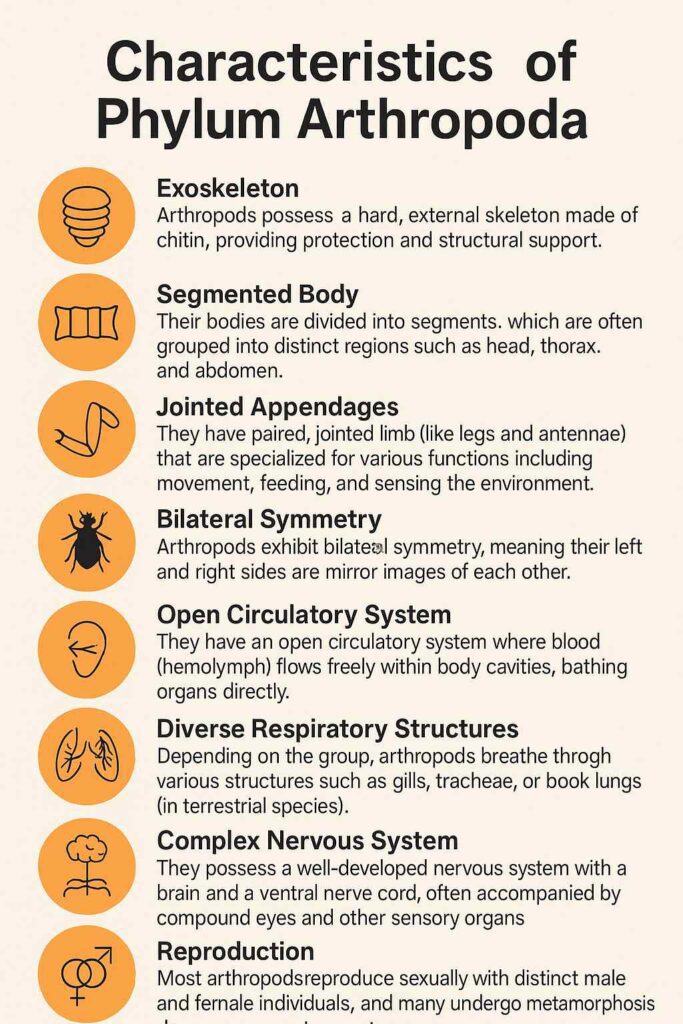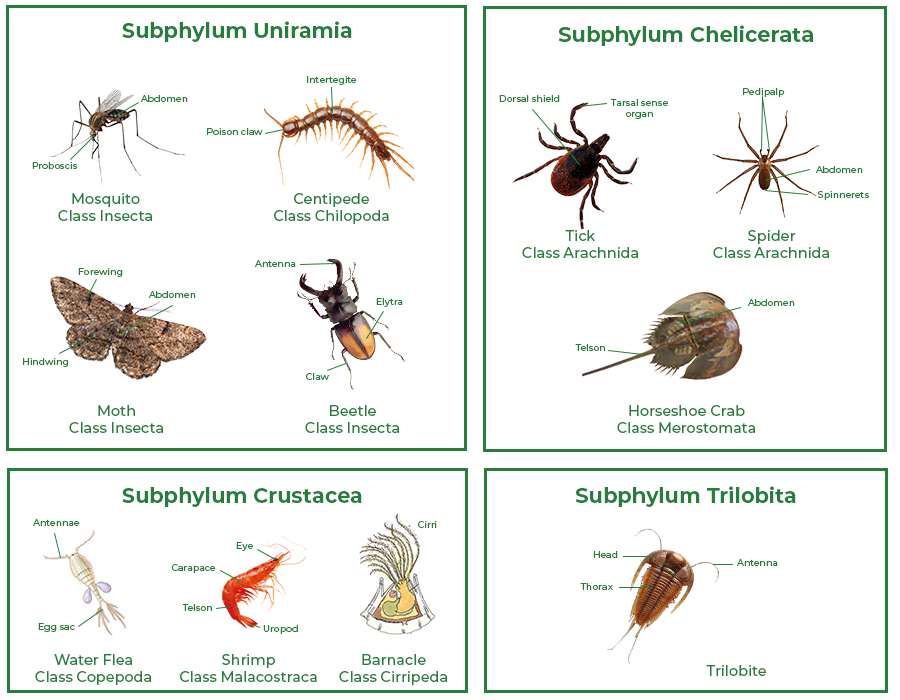What is Phylum Arthropoda?

Phylum Arthropoda is the largest group in the animal kingdom, encompassing over a million described species, including insects, spiders, crabs, and centipedes. These animals are characterized by their segmented bodies, jointed appendages, and a hard exoskeleton made of chitin, which they periodically shed to grow a process known as molting. Arthropods have a bilateral body symmetry and an open circulatory system, where blood flows through a hemocoel.
They possess a well-developed nervous system with a brain and a ventral nerve cord, and their sensory organs can include compound eyes and antennae. Respiration varies among groups: insects breathe through tracheae, aquatic crustaceans use gills, and arachnids have book lungs or tracheae. Excretion is carried out by structures like Malpighian tubules or green glands. Reproduction is typically sexual, with most species having separate sexes and undergoing complex life cycles, often involving metamorphosis.
Summary of Phylum Arthropoda
- Arthropods are the most diverse and abundant animals, including insects, spiders, crabs, and centipedes, found in almost every environment on Earth.
- They have a segmented body, jointed legs, and a tough exoskeleton that protects and supports them as they grow and move.
- Arthropods play essential roles in nature—from pollination and decomposition to being a major part of the food chain and even benefiting humans directly.
Table of Contents
General Characteristics of Phylum Arthropoda

The general characteristics of Phylum Arthropoda,
1. Exoskeleton and Molting
Arthropods have a hard outer covering called an exoskeleton, made primarily of chitin. This exoskeleton provides protection and support but doesn’t grow with the animal. Therefore, arthropods must shed their exoskeleton through a process called molting to allow for growth.
2. Segmented Body Structure
Their bodies are divided into segments, which are often grouped into distinct regions such as the head, thorax, and abdomen. This segmentation allows for specialization of body regions for different functions.
3. Jointed Appendages
A defining feature of arthropods is their jointed appendages limbs with joints that allow for a wide range of movements. These appendages are adapted for various functions, including walking, feeding, sensing the environment, and reproduction.
4. Bilateral Symmetry
Arthropods exhibit bilateral symmetry, meaning their left and right sides are mirror images of each other. This symmetry is associated with a centralized nervous system and streamlined body shape.
5. Open Circulatory System
They possess an open circulatory system where blood, or hemolymph, is not entirely contained within vessels. Instead, it flows freely through body cavities, bathing the internal organs directly.
6. Diverse Respiratory Structures
Arthropods have evolved various respiratory systems to suit their environments:
- Gills in aquatic species like crustaceans.
- Tracheal systems in insects and myriapods, consisting of a network of tubes that deliver oxygen directly to tissues.
- Book lungs or book gills in arachnids and horseshoe crabs, which are layered structures facilitating gas exchange.
7. Advanced Nervous System and Sensory Organs
Arthropods possess a well-developed nervous system, including a brain and a ventral nerve cord with segmental ganglia. They have complex sensory organs:
- Compound eyes that provide a broad field of vision and detect movement effectively.
- Antennae for sensing touch, chemicals, and vibrations.
- Other specialized receptors for detecting environmental cues.
8. Efficient Digestive and Excretory Systems
Arthropods have a complete digestive system with a mouth, esophagus, stomach, intestines, and anus. Their mouthparts are adapted to various feeding habits, including biting, chewing, sucking, or piercing. Excretion is managed by specialized organs:
- Malpighian tubules in insects and arachnids, which remove waste from the hemolymph.
- Green glands or antennal glands in crustaceans, which filter waste from the blood.
9. Reproduction and Development
Most arthropods reproduce sexually, with distinct male and female individuals. Fertilization can be internal or external, depending on the species. Many arthropods undergo metamorphosis a transformation from larval to adult stages—which can be complete (egg, larva, pupa, adult) or incomplete (egg, nymph, adult).
10. Adaptability and Ecological Diversity
Arthropods are incredibly adaptable, inhabiting nearly every ecosystem on Earth, from deep oceans to high mountains. Their diverse forms and behaviors allow them to occupy various ecological niches as predators, prey, decomposers, and pollinators. This adaptability has made them the most numerous and diverse group in the animal kingdom.
These comprehensive characteristics highlight the complexity and adaptability of arthropods, contributing to their success and diversity across the planet.
Classification of Phylum Arthropoda

1. Subphylum Trilobitomorpha (Extinct)
Trilobitomorpha comprises the extinct group of arthropods known as trilobites. These marine arthropods were abundant during the Paleozoic era but disappeared in the Permian period. Trilobites had a distinctive three-lobed body structure and are primarily known from fossil records.
2. Subphylum Chelicerata
Chelicerata includes arthropods such as spiders, scorpions, horseshoe crabs, and sea spiders. These animals typically have two main body parts: the cephalothorax (combined head and thorax) and the abdomen. They possess chelicerae, which are specialized mouthparts used for feeding, and lack antennae. Respiration occurs through gills, tracheae, or book lungs, depending on the species.
3. Subphylum Crustacea
Crustaceans are primarily aquatic arthropods that include crabs, lobsters, shrimp, and barnacles. They have a hard exoskeleton and typically two pairs of antennae. Crustaceans exhibit a wide range of body forms and sizes, from microscopic copepods to large lobsters.
4. Subphylum Myriapoda
Myriapods are terrestrial arthropods characterized by elongated bodies with numerous segments, each bearing one or two pairs of legs. This subphylum includes millipedes (Diplopoda), centipedes (Chilopoda), and other less-known groups like pauropods and symphylans. They typically have a pair of antennae and simple eyes.
5. Subphylum Hexapoda
Hexapods are arthropods with six legs and a body divided into three distinct regions: head, thorax, and abdomen. This subphylum includes insects and entognathans. Insects are the most diverse group within this subphylum, exhibiting a vast array of forms and behaviors. They are found in nearly every habitat on Earth.
Conclusion
Phylum Arthropoda stands as the most diverse and abundant group in the animal kingdom, encompassing a vast array of species that have successfully adapted to nearly every habitat on Earth. Their defining features such as a segmented body, jointed appendages, and a chitinous exoskeleton have enabled them to thrive in environments ranging from deep oceans to arid deserts. The phylum is categorized into several subphyla, including Chelicerata (spiders and scorpions), Crustacea (crabs and lobsters), Myriapoda (centipedes and millipedes), and Hexapoda (insects), each exhibiting unique adaptations that contribute to their ecological success.
Understanding the characteristics and classifications of arthropods provides insight into their evolutionary success and the critical roles they play in ecosystems worldwide.
Frequently Asked Questions (FAQs)
Why is Arthropoda the largest phylum?
Arthropoda is the largest phylum because it has the most animal species on Earth. They can live in land, water, and air, and have strong bodies with jointed legs and hard exoskeletons. They also reproduce quickly and come in many forms like insects, spiders, and crabs.
What are the 5 classes of Phylum Arthropoda?
The five main classes of Phylum Arthropoda are:
Insecta – Includes insects like ants, butterflies, and flies.
Arachnida – Includes spiders, scorpions, ticks, and mites.
Crustacea – Includes crabs, lobsters, shrimp, and barnacles.
Chilopoda – Includes centipedes, which have one pair of legs per body segment.
Diplopoda – Includes millipedes, which have two pairs of legs per body segment.
Why is Phylum Arthropoda called as a most successful phylum?
Phylum Arthropoda is called the most successful phylum because it has the largest number of species, including insects, spiders, and crabs. They live everywhere on land, in water, and air. Their hard outer shell (exoskeleton) protects them and prevents water loss. With jointed legs, they move quickly. They have strong senses like good eyes and antennae. They also reproduce fast in large numbers. These features help them survive in many environments, making them the most successful group of animals.
Related Articles

